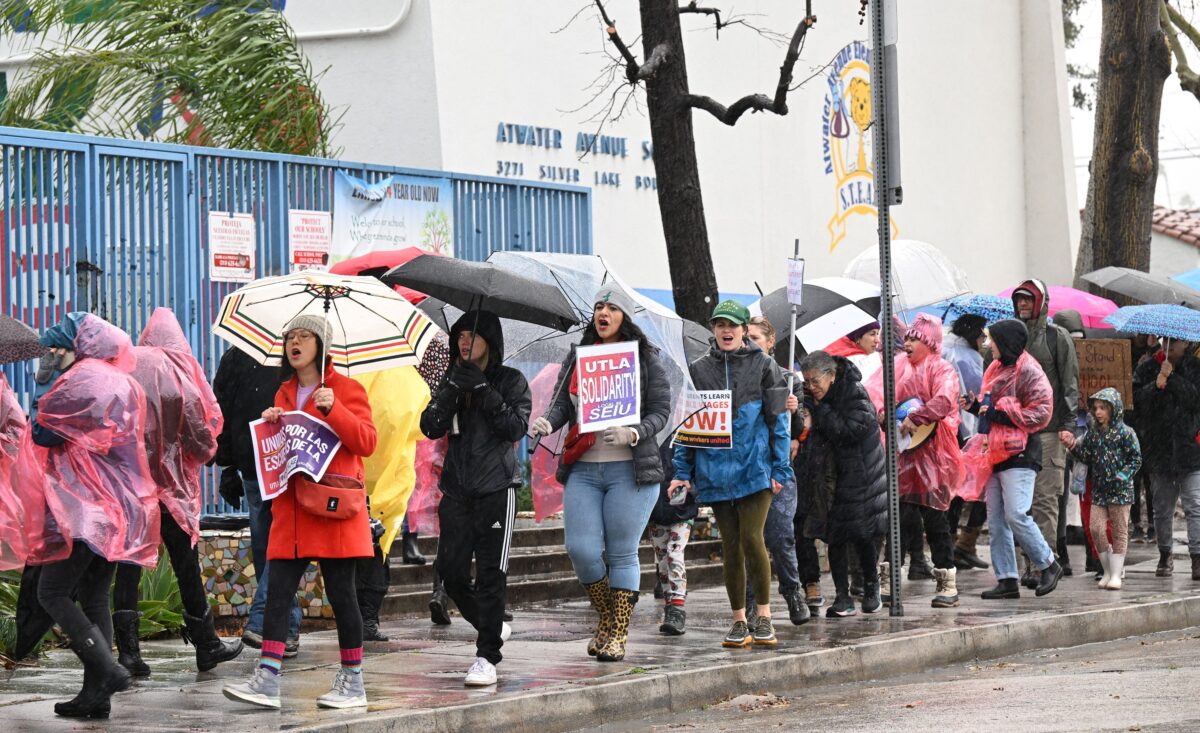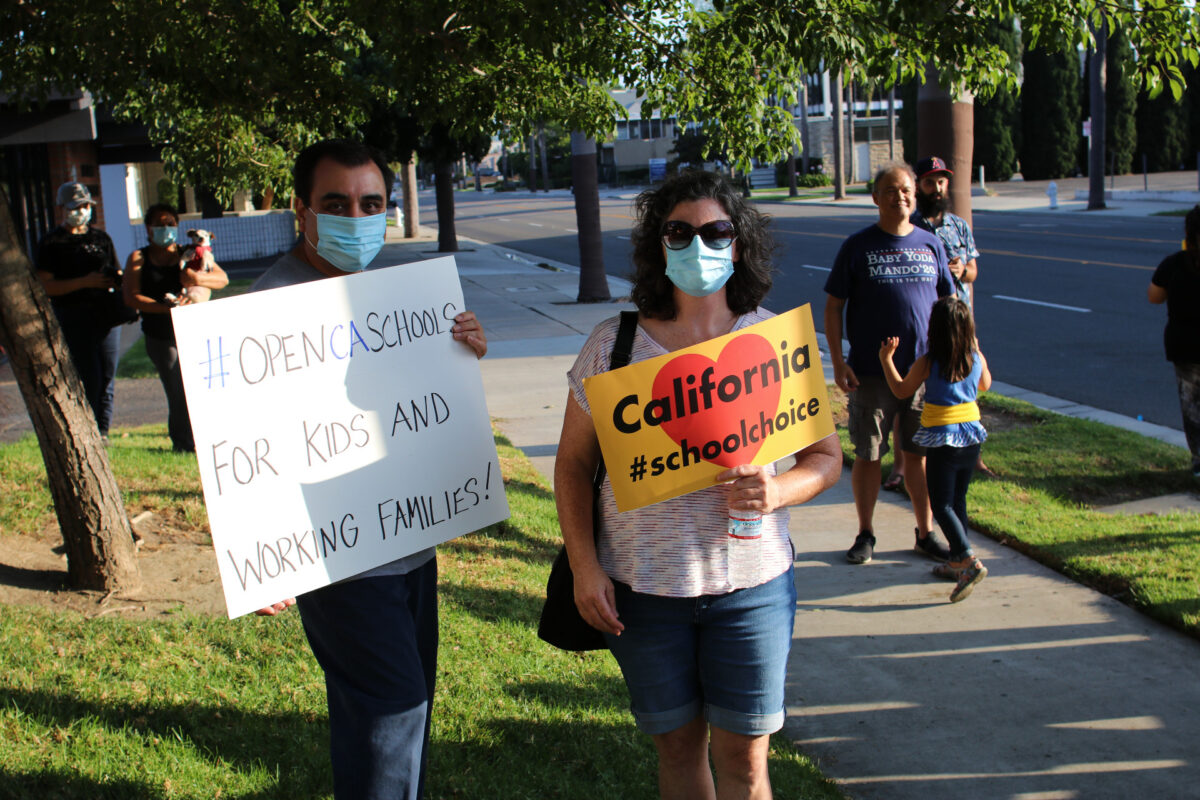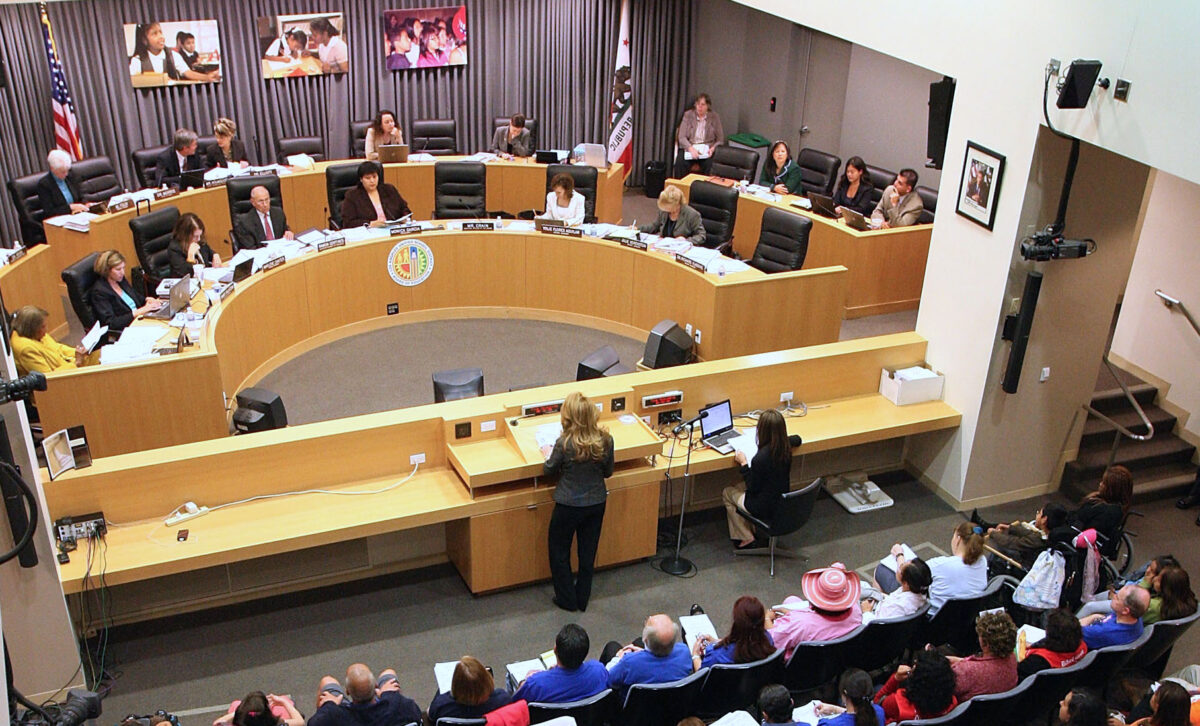LAUSD Strike Demonstrates Massive Union Power
Commentary The Los Angeles Unified School District shuttered school doors March 21 after a strike by Local 99 members of the Service Employees International Union, which represents non-teaching employees. The United Teachers of Los Angeles, which represents teachers, joined the strike. The district’s 420,000 students are at home for the expected three-day duration of the strike. Well, at least they’re avoiding the heavy rains. But even if the strike is called off quickly, the walkout shows the massive power of public-employee unions in California. They run the Democratic Party, and through it the state Legislature, the governor, and most members of Congress. Police unions commonly have great influence on city councils, sheriffs’ unions on boards of education, and the teachers’ unions on school boards. The LAUSD’s unions also have clout throughout Southern California. During the COVID lockdowns, the UTLA forced the kids to be kept home longer than in most districts. But a friend of mine who taught in the Santa Ana Unified School District said their union simply copied whatever was pushed by the UTLA, meaning excessive lockdowns. Los Angeles public school support workers, teachers, and supporters walk the picket line in front of an elementary school in Los Angeles on March 21, 2023. (Robyn Beck/AFP via Getty Images) The 2018 Janus v. AFSCME decision by the U.S. Supreme Court did reduce union power. It allowed anyone to refuse to pay union dues. Yet union clout has been reduced only slightly, especially in California. A December 2021 study by the Manhattan Institute found: “However, the unions’ fortunes have not fluctuated nearly as much as many predicted. Although the unions lost agency fee revenue and even some members, the effects of Janus have, to date, been far less catastrophic than the dire consequences sketched by union advocates or as predicted by Justice Elena Kagan in her Janus dissent.” Moreover, in California the Legislature acted to blunt Janus’s effect. On the day the decision was handed down in 2018, Gov. Jerry Brown signed into law Senate Bill 886. According to the San Diego Bar Association, “The bill was designed to give public sector unions more control over the dues authorization process by (1) ensuring employer cooperation in administering dues deductions and (2) limiting employer communications concerning employee representation.” COVID Lockdown Damage The results of the excessive COVID lockdowns, and massive union power, have been devastating to the students. California school test scores, already among the lowest in the country, dropped even further. A Public Policy Institute of California analysis last December found: “Before the pandemic, California was in the midst of major reforms to its funding, assessment, and accountability systems; those reforms showed encouraging signs of progress. Then lockdowns and school closures disrupted much of that progress: schools remained closed for an average of 115 days into 2021, with closures often lasting longer in districts that served high shares of Black, Latino, or low-income students …. “Math proficiency among low-income students decreased from 32% pre-pandemic to 24% this spring. Among Black students, math proficiency was 15%, the lowest of all racial, ethnic, economic status, and English Learner groups—although among students ever classified as English Learners, math proficiency fell from 29% to 19%.” School buses line up in Los Angeles on Aug. 30, 2021. (Mike Blake/Reuters) What a disaster. Of course, even early in the pandemic, it was clear young people were the least affected by the disease, with the death rate much lower than for older people. A Jan. 30, 2023 study in the Journal of the American Medical Association found that, although deaths increased among children because of COVID, those deaths still were at a low level: “Among children and young people aged 0 to 19 years in the US, COVID-19 ranked eighth among all causes of deaths, fifth in disease-related causes of deaths (excluding unintentional injuries, assault, and suicide), and first in deaths caused by infectious or respiratory diseases. COVID-19 deaths constituted 2 percent of all causes of death in this age group …. “In the 12-month period August 1, 2021, to July 31, 2022, there were more than 360 000 deaths from COVID-19 in the US (a rate of 109 per 100 000 population). In children and young people (CYP) aged 0 to 19 years, there were 821 deaths from COVID-19 reported in this time period (1.0 per 100 000 population).” Compare the two: per 100,000 population, 1.0 deaths for children, 109 for the whole population. That is, children died at a rate of less than 1 percent of that of the general population. For that, the kids were locked out of school, their educations degraded, and their social life distorted. The latter is important, too. A May 19, 2021 study in Pediatric Clinics of North America found: “The transition to an online education during the cor

Commentary
The Los Angeles Unified School District shuttered school doors March 21 after a strike by Local 99 members of the Service Employees International Union, which represents non-teaching employees. The United Teachers of Los Angeles, which represents teachers, joined the strike. The district’s 420,000 students are at home for the expected three-day duration of the strike. Well, at least they’re avoiding the heavy rains.
But even if the strike is called off quickly, the walkout shows the massive power of public-employee unions in California. They run the Democratic Party, and through it the state Legislature, the governor, and most members of Congress. Police unions commonly have great influence on city councils, sheriffs’ unions on boards of education, and the teachers’ unions on school boards.
The LAUSD’s unions also have clout throughout Southern California. During the COVID lockdowns, the UTLA forced the kids to be kept home longer than in most districts. But a friend of mine who taught in the Santa Ana Unified School District said their union simply copied whatever was pushed by the UTLA, meaning excessive lockdowns.

The 2018 Janus v. AFSCME decision by the U.S. Supreme Court did reduce union power. It allowed anyone to refuse to pay union dues. Yet union clout has been reduced only slightly, especially in California. A December 2021 study by the Manhattan Institute found:
“However, the unions’ fortunes have not fluctuated nearly as much as many predicted. Although the unions lost agency fee revenue and even some members, the effects of Janus have, to date, been far less catastrophic than the dire consequences sketched by union advocates or as predicted by Justice Elena Kagan in her Janus dissent.”
Moreover, in California the Legislature acted to blunt Janus’s effect. On the day the decision was handed down in 2018, Gov. Jerry Brown signed into law Senate Bill 886. According to the San Diego Bar Association, “The bill was designed to give public sector unions more control over the dues authorization process by (1) ensuring employer cooperation in administering dues deductions and (2) limiting employer communications concerning employee representation.”
COVID Lockdown Damage
The results of the excessive COVID lockdowns, and massive union power, have been devastating to the students. California school test scores, already among the lowest in the country, dropped even further. A Public Policy Institute of California analysis last December found:
“Before the pandemic, California was in the midst of major reforms to its funding, assessment, and accountability systems; those reforms showed encouraging signs of progress. Then lockdowns and school closures disrupted much of that progress: schools remained closed for an average of 115 days into 2021, with closures often lasting longer in districts that served high shares of Black, Latino, or low-income students ….
“Math proficiency among low-income students decreased from 32% pre-pandemic to 24% this spring. Among Black students, math proficiency was 15%, the lowest of all racial, ethnic, economic status, and English Learner groups—although among students ever classified as English Learners, math proficiency fell from 29% to 19%.”

What a disaster. Of course, even early in the pandemic, it was clear young people were the least affected by the disease, with the death rate much lower than for older people. A Jan. 30, 2023 study in the Journal of the American Medical Association found that, although deaths increased among children because of COVID, those deaths still were at a low level:
“Among children and young people aged 0 to 19 years in the US, COVID-19 ranked eighth among all causes of deaths, fifth in disease-related causes of deaths (excluding unintentional injuries, assault, and suicide), and first in deaths caused by infectious or respiratory diseases. COVID-19 deaths constituted 2 percent of all causes of death in this age group ….
“In the 12-month period August 1, 2021, to July 31, 2022, there were more than 360 000 deaths from COVID-19 in the US (a rate of 109 per 100 000 population). In children and young people (CYP) aged 0 to 19 years, there were 821 deaths from COVID-19 reported in this time period (1.0 per 100 000 population).”
Compare the two: per 100,000 population, 1.0 deaths for children, 109 for the whole population. That is, children died at a rate of less than 1 percent of that of the general population. For that, the kids were locked out of school, their educations degraded, and their social life distorted. The latter is important, too.
A May 19, 2021 study in Pediatric Clinics of North America found:
“The transition to an online education during the coronavirus disease 2019 (COVID-19) pandemic may bring about adverse educational changes and adverse health consequences for children and young adult learners in grade school, middle school, high school, college, and professional schools ….
“Another major concern is the length of isolation many children have had to endure since the pandemic began and what effects it might have on their ability to socialize. The school, for many children, is the agent for forming their social connections as well as where early social development occurs. Noting that academic performance is also declining the pandemic may be creating a snowball effect, setting back children without access to resources from which they may never recover, even into adulthood ….
“Although COVID-19 has affected all levels of education reception and delivery, children with special needs have been more profoundly impacted.”

The thing is, most school districts in California were not as draconian in their lockdowns as LAUSD and Santa Ana Unified. Other states were even more realistic. Gov. Ron DeSantis of Florida has touted how his state did much better on tests than California, New York, and other states with strict lockdowns. He said in a statement last October:
“We insisted on keeping schools open and guaranteed in-person learning in 2020 because we knew there would be widespread harm to our students if students were locked out. Today’s results once again prove that we made the right decision. We also knew that younger and at-risk students would be the most impacted if schools were closed, and the results speak for themselves. In Florida our 4th grade students rank #3 in Reading and #4 in Math, achieving top 4 in both English and Math for the first time in state history, while lockdown California and New York aren’t even in the top 30.”
Obviously, DeSantis is running for president. But the numbers speak for themselves. And in Florida, union power is much lower than in California. Public employees are not even allowed to strike in the Sunshine State, according to state law.
LAUSD’s Collapsing Finances
Finally, as I like to do, it’s worth following former state Sen. John Moorlach’s example and always checking the finances, in this case of LAUSD. According to its audited financial report for June 30, 2022:
“The Unrestricted Net Position improved by $1.0 billion from a negative $16.36 billion to a negative $15.36 billion. The negative Unrestricted New Position is largely the result of our other postemployment (OPEB) liability and pension liabilities for various retirement plans. The noted improvement is primarily attributable to the receipt of COVID-19 funding and various cost savings.”

The OPEB is mainly for retiree medical care. And that “improved” $15.35 billion position still is horrible. Divided by Los Angeles’s 3.849 million population, the debt comes to $3,988 per person, or $15,952 for a family of four.
And of course, not only is the COVID-19 funding over, so is the $100 billion state surplus, even as Los Angeles’s financial position slips with the rest of the nation into recession. That all means there’s just no money for the exorbitant demands of the striking unions. Indeed, if the onrushing recession gets bad enough, the LAUSD risks bankruptcy.
Perhaps some day Californians will wake up and put the people, especially the students, above union power.
Views expressed in this article are the opinions of the author and do not necessarily reflect the views of The Epoch Times.












